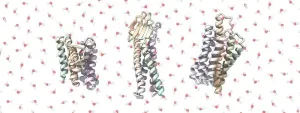(Press-News.org) Many drug and antibody discovery pathways focus on intricately folded cell membrane proteins: when molecules of a drug candidate bind to these proteins, like a key going into a lock, they trigger chemical cascades that alter cellular behavior. But because these proteins are embedded in the lipid-containing outer layer of cells, they are tricky to access and insoluble in water-based solutions (hydrophobic), making them difficult to study.
"We wanted to get these proteins out of the cell membrane, so we redesigned them as hyperstable, soluble analogues, which look like membrane proteins but are much easier to work with,” explains Casper Goverde, a PhD student in the Laboratory of Protein Design and Immunoengineering (LPDI) in the School of Engineering.
In a nutshell, Goverde and a research team in the LPDI, led by Bruno Correia, used deep learning to design synthetic soluble versions of cell membrane proteins commonly used in pharmaceutical research. Whereas traditional screening methods rely on indirectly observing cellular reactions to drug and antibody candidates, or painstakingly extracting small quantities of membrane proteins from mammalian cells, the researchers’ computational approach allows them to remove cells from the equation. After designing a soluble protein analogue using their deep learning pipeline, they can use bacteria to produce the modified protein in bulk. These proteins can then bind directly in solution with molecular candidates of interest.
“We estimate that producing a batch of soluble protein analogues using E. coli is around 10 times less expensive than using mammalian cells,” adds PhD student Nicolas Goldbach.
The team’s research has recently been published in the journal Nature.
Flipping the script on protein design
In recent years, scientists have successfully harnessed artificial intelligence networks that use deep learning to design novel protein structures, for example by predicting them based on an input sequence of amino acid building blocks. But for this study, the researchers were interested in protein folds that already exist in nature; what they needed was a more accessible, soluble version of these proteins.
“We had the idea to invert this deep learning pipeline that predicts protein structure: if we input a structure, can it tell us the corresponding amino acid sequence?” explains Goverde.
To achieve this, the team used the structure prediction platform AlphaFold2 from Google DeepMind to produce amino acid sequences for soluble versions of several key cell membrane proteins, based on their 3D structure. Then, they used a second deep learning network, ProteinMPNN, to optimize those sequences for functional, soluble proteins. The researchers were pleased to discover that their approach showed remarkable success and accuracy in producing soluble proteins that maintained parts of their native functionality, even when applied to highly complex folds that have so far eluded other design methods.
“The holy grail of biochemistry”
A particular triumph of the study was the pipeline’s success in designing a soluble analogue of a protein shape known as the G-protein coupled receptor (GPCR), which represents around 40% of human cell membrane proteins and is a major pharmaceutical target.
“We showed for the first time that we can redesign the GPCR shape as a stable soluble analogue. This has been a long-standing problem in biochemistry, because if you can make it soluble, you can screen for novel drugs much faster and more easily,” says LPDI scientist Martin Pacesa.
The researchers also see these results as a proof-of-concept for their pipeline’s application to vaccine research, and even cancer therapeutics. For example, they designed a soluble analogue of a protein type called a claudin, which plays a role in making tumors resistant to the immune system and chemotherapy. In their experiments, the team’s soluble claudin analogue retained its biological properties, reinforcing the pipeline’s promise for generating interesting targets for pharmaceutical development.
END
Membrane protein analogues could accelerate drug discovery
EPFL researchers have created a deep learning pipeline for designing soluble analogues of key protein structures used in pharmaceutical development, sidestepping the prohibitive cost of extracting these proteins from cell membranes.
2024-06-21
ELSE PRESS RELEASES FROM THIS DATE:
Berkeley Lab researchers advance AI-driven plant root analysis
2024-06-21
In a world striving for sustainability, understanding the hidden half of a living plant – the roots – is crucial. Roots are not just an anchor; they are a dynamic interface between the plant and soil, critical for water uptake, nutrient absorption, and, ultimately, the survival of the plant. In an investigation to boost agricultural yields and develop crops resilient to climate change, scientists from Lawrence Berkeley National Laboratory’s (Berkeley Lab’s) Applied Mathematics and Computational Research (AMCR) and Environmental Genomics and Systems Biology (EGSB) Divisions have made a significant leap. Their latest innovation, RhizoNet, harnesses the power ...
Cleveland Clinic study shows weight loss surgery cuts risk of heart complications and death in patients with obstructive sleep apnea and obesity
2024-06-21
Press release under embargo:
Cleveland Clinic Study Shows Weight Loss Surgery Cuts Risk of Heart Complications and Death in Patients with Obstructive Sleep Apnea and Obesity
First-of-its-kind MOSAIC study shows weight-loss surgery is associated with a 42% reduction in risk of heart complications and 37% reduction in risk of death in patients with obstructive sleep apnea
Under embargo until Friday, June 21, 2024, 9:00 AM ET, CLEVELAND: A Cleveland Clinic study shows that bariatric surgery performed in patients with obesity and moderate to severe obstructive sleep apnea is associated with a significantly lower risk of ...
SQUID pries open AI black box
2024-06-21
Artificial intelligence continues to squirm its way into many aspects of our lives. But what about biology, the study of life itself? AI can sift through hundreds of thousands of genome data points to identify potential new therapeutic targets. While these genomic insights may appear helpful, scientists aren’t sure how today’s AI models come to their conclusions in the first place. Now, a new system named SQUID arrives on the scene armed to pry open AI’s black box of murky internal logic.
SQUID, ...
Resiliency shaped by activity in the gut microbiome and brain
2024-06-21
A new UCLA Health study has found that resilient people exhibit neural activity in the brain regions associated with improved cognition and regulating of emotions, and were more mindful and better at describing their feelings. The same group also exhibited gut microbiome activity linked to a healthy gut, with reduced inflammation and gut barrier.
For the study, rather than examine microbiome activity and composition linked to disease conditions-- like anxiety and depression -- the researchers wanted to flip the script and study the gut microbiome and brain in healthy, resilient people who effectively cope with different types of stress, including discrimination ...
Inspired by nature: synthetic nightshade molecule effective against leukemia cells
2024-06-21
Nightshade plants produce a diverse array of compounds with therapeutic potential. Researchers at CeMM have now identified an artificial variant inspired by the Withanolides group that acts highly specifically against leukemia cells. Using state-of-the-art chemical and genetic high-throughput analyses, the team led by Georg Winter not only confirmed its effectiveness but also elucidated its mechanism of action: the molecule disrupts the cholesterol metabolism of tumor cells. The study's findings ...
Promise green hydrogen may not always be fulfilled
2024-06-21
Green hydrogen often, but certainly not always, leads to CO2 gains. This claim is based on research published in Nature Energy by Kiane de Kleijne from Radboud University and Eindhoven University of Technology. “If you calculate the entire life cycle of green hydrogen production and transport, CO2 gains may be disappointing. However, if green hydrogen is produced from very clean electricity and locally, it can really help reduce emissions.”
It is thought that green hydrogen can make ...
Unifying behavioral analysis through animal foundation models
2024-06-21
Although there is the saying, “straight from the horse’s mouth”, it's impossible to get a horse to tell you if it's in pain or experiencing joy. Yet, its body will express the answer in its movements. To a trained eye, pain will manifest as a change in gait, or in the case of joy, the facial expressions of the animal could change. But what if we can automate this with AI? And what about AI models for cows, dogs, cats, or even mice? Automating animal behavior not only removes observer bias, but it helps humans more efficiently get to the right answer.
Today ...
Up to 30 percent more time: Climate change makes it harder for women to collect water
2024-06-21
Climate change could increase the amount of time women spend collecting water by up to 30 percent globally by 2050, according to a new study published in Nature Climate Change. In regions of South America and Southeast Asia, the time spent collecting water could double due to higher temperatures and less rainfall. A team of scientists from the Potsdam Institute for Climate Impact Research (PIK) estimates the large welfare losses that could result from climate impacts and highlights how women are particularly vulnerable to changing future climate conditions. Worldwide, two billion people currently lack access to safe drinking water. The ...
Heart failure in space: scientists calculate potential health threats facing future space tourists in microgravity
2024-06-21
[The following is a guest editorial written by Dr Lex van Loon, an assistant professor at the Australian National University and the University of Twente in the Netherlands. He is co-author of a new Frontiers in Physiology article.]
Space exploration has always captivated our imagination, offering the promise of discovering new worlds and pushing the boundaries of human capability. As commercial space travel becomes more accessible, individuals with various underlying health conditions—including heart failure—may soon be among those venturing beyond Earth’s atmosphere. This raises critical questions about the impact of space travel ...
Experts offer guidance on talking with children about racism at pediatrician's office
2024-06-21
Extensive research shows the link between exposure to racism during childhood and adolescence and increased risks of depression and metabolic health issues, such as obesity, diabetes and heart disease. Conversely, racial socialization, described as behaviors and practices that teach children about race and ethnic identity, has shown potential in mitigating these negative effects, and discussions like these could be effective in pediatric clinics, according to the first expert consensus guidance on this topic published in Pediatrics.
“Over the years, numerous calls to action have been made to address racism in medicine. ...
LAST 30 PRESS RELEASES:
Global psychiatry mourns Professor Dan Stein, visionary who transformed mental health science across Africa and beyond
KIST develops eco-friendly palladium recovery technology to safeguard resource security
Statins significantly reduce mortality risk for adults with diabetes, regardless of cardiovascular risk
Brain immune cells may drive more damage in females than males with Alzheimer’s
Evidence-based recommendations empower clinicians to manage epilepsy in pregnancy
Fungus turns bark beetles’ defenses against them
There are new antivirals being tested for herpesviruses. Scientists now know how they work
CDI scientist, colleagues author review of global burden of fungus Candida auris
How does stroke influence speech comprehension?
B cells transiently unlock their plasticity, risking lymphoma development
Advanced AI dodel predicts spoken language outcomes in deaf children after cochlear implants
Multimodal imaging-based cerebral blood flow prediction model development in simulated microgravity
Accelerated streaming subgraph matching framework is faster, more robust, and scalable
Gestational diabetes rose every year in the US since 2016
OHSU researchers find breast cancer drug boosts leukemia treatment
Fear and medical misinformation regarding risk of progression or recurrence among patients with breast cancer
Glucagonlike peptide-1 receptor agonists and asthma risk in adolescents with obesity
Reviving dormant immunity: Millimeter waves reprogram the immunosuppressive microenvironment to potentiate immunotherapy without obvious side effects
Safety decision-making for autonomous vehicles integrating passenger physiological states by fNIRS
Fires could emit more air pollution than previously estimated
A new way to map how cells choose their fate
Numbers in our sights affect how we perceive space
SIMJ announces global collaborative book project in commemoration of its 75th anniversary
Air pollution exposure and birth weight
Obstructive sleep apnea risk and mental health conditions among older adults
How talking slows eye movements behind the wheel
The Ceramic Society of Japan’s Oxoate Ceramics Research Association launches new international book project
Heart-brain connection: international study reveals the role of the vagus nerve in keeping the heart young
Researchers identify Rb1 as a predictive biomarker for a new therapeutic strategy in some breast cancers
Survey reveals ethical gaps slowing AI adoption in pediatric surgery
[Press-News.org] Membrane protein analogues could accelerate drug discoveryEPFL researchers have created a deep learning pipeline for designing soluble analogues of key protein structures used in pharmaceutical development, sidestepping the prohibitive cost of extracting these proteins from cell membranes.





